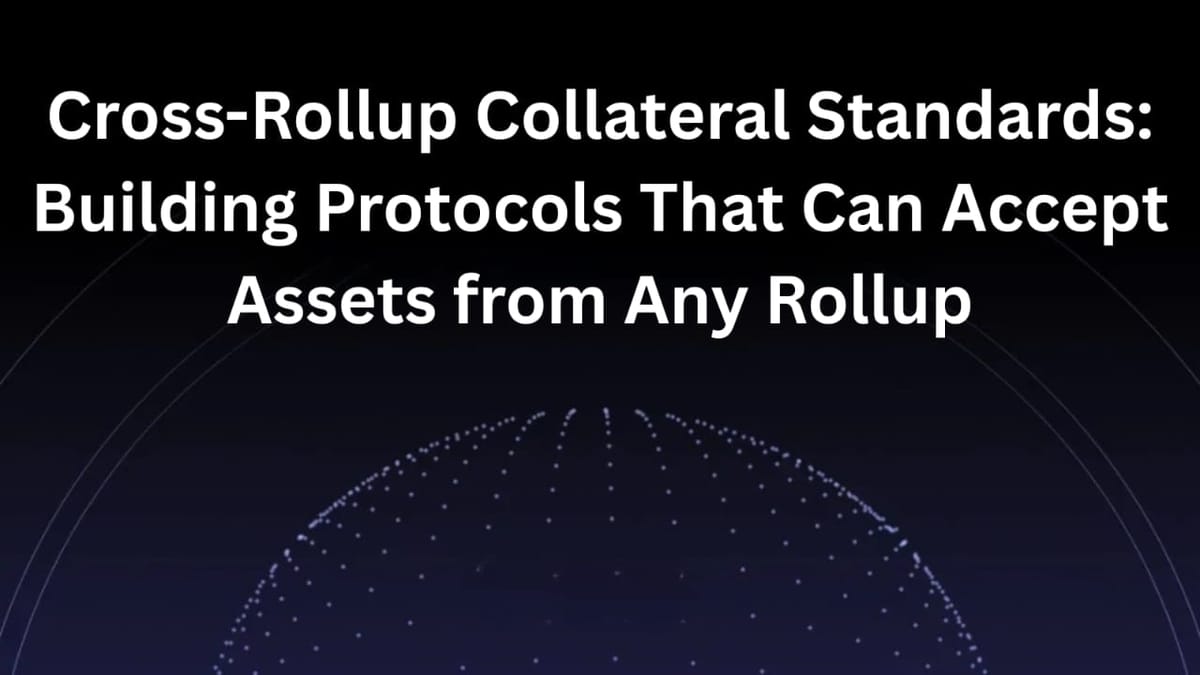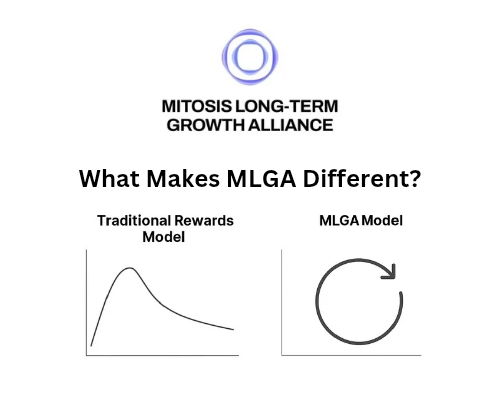Cross-Rollup Collateral Standards: Building Protocols That Can Accept Assets from Any Rollup

Introduction
As the decentralized finance (DeFi) ecosystem continues to expand, the emergence of rollups has become a pivotal development in enhancing scalability and reducing transaction costs on Ethereum and other blockchains. Rollups, which bundle multiple transactions into a single batch, allow for greater throughput and efficiency. However, the proliferation of various rollup solutions such as Arbitrum, Base, Linea, and ZKSync has led to fragmentation in the DeFi landscape. This fragmentation poses challenges for liquidity, interoperability, and asset management across different rollups. To address these challenges, the concept of Cross-Rollup Collateral Standards (CRCS) has emerged, aiming to create a unified framework that allows protocols to accept assets from any rollup seamlessly. This article explores the importance of CRCS, its potential benefits, and the mechanisms required to implement such standards.
1. Understanding Rollups and Their Importance
1.1 What are Rollups?
Rollups are Layer 2 scaling solutions that execute transactions off-chain while maintaining the security of the underlying blockchain (Layer 1). They achieve this by bundling multiple transactions into a single proof, which is then submitted to the main chain. There are two primary types of rollups:
- Optimistic Rollups: These rollups assume that transactions are valid by default and only perform fraud proofs when a challenge is raised. Examples include Arbitrum and Optimism.
- Zero-Knowledge Rollups (ZK-Rollups): These rollups use cryptographic proofs to validate transactions, ensuring that only valid transactions are included in the batch. Examples include ZKSync and StarkWare.
1.2 The Benefits of Rollups
- Scalability: Rollups significantly increase transaction throughput, allowing for thousands of transactions per second (TPS) compared to the limited capacity of Layer 1 blockchains.
- Lower Fees: By aggregating transactions, rollups reduce the cost per transaction, making DeFi more accessible to users.
- Enhanced User Experience: Faster transaction confirmations and lower fees improve the overall user experience in DeFi applications.
1.3 The Challenge of Fragmentation
Despite the advantages of rollups, the proliferation of different rollup solutions has led to fragmentation in the DeFi ecosystem. Each rollup operates independently, creating silos of liquidity and assets. This fragmentation poses several challenges:
- Liquidity Isolation: Assets locked in one rollup cannot be easily utilized in another, leading to inefficiencies and missed opportunities for yield generation.
- Complexity for Users: Users must navigate multiple rollups, each with its own protocols and standards, complicating asset management and participation in DeFi.
- Inconsistent Standards: The lack of standardized collateral protocols across rollups makes it difficult for developers to create interoperable applications.
2. The Need for Cross-Rollup Collateral Standards (CRCS)
2.1 What are Cross-Rollup Collateral Standards?
Cross-Rollup Collateral Standards (CRCS) refer to a unified framework that allows DeFi protocols to accept and manage assets from any rollup seamlessly. By establishing common standards for collateralization, CRCS aims to enhance interoperability, liquidity, and user experience across different rollup solutions.
2.1 Key Objectives of CRCS
- Interoperability: CRCS aims to create a seamless experience for users, allowing them to move assets freely between rollups without the need for complex bridging solutions.
- Liquidity Aggregation: By enabling protocols to accept collateral from multiple rollups, CRCS can help aggregate liquidity, improving market depth and reducing slippage.
- Standardization: Establishing common standards for collateralization will simplify the development of DeFi applications, allowing developers to focus on building innovative solutions rather than dealing with compatibility issues.
- User Empowerment: CRCS will empower users by providing them with greater flexibility and control over their assets, enabling them to participate in DeFi across multiple rollups.
3. Mechanisms for Implementing Cross-Rollup Collateral Standards
1. Unified Asset Representation
To facilitate cross-rollup collateralization, a unified asset representation system is essential. This system would involve creating standardized token representations that can be recognized across different rollups. Key components include:
- Wrapped Tokens: Similar to Wrapped Bitcoin (WBTC), which represents Bitcoin on Ethereum, CRCS could utilize wrapped tokens to represent assets across rollups. For example, a token representing ETH on Arbitrum could be wrapped and recognized on ZKSync.
- Interoperable Token Standards: Developing a common token standard, such as ERC-20 or ERC-721, that can be implemented across rollups will ensure compatibility and ease of use.
2. Cross-Rollup Bridges
Cross-rollup bridges are essential for facilitating the transfer of assets between different rollups. These bridges would enable users to move their assets seamlessly, ensuring that collateral can be utilized across various DeFi protocols. Key considerations include:
- Security: Ensuring the security of cross-rollup bridges is paramount. Utilizing decentralized or multi-signature mechanisms can help mitigate risks associated with asset transfers.
- Efficiency: Bridges should be designed to minimize transaction costs and delays, providing users with a smooth experience when moving assets between rollups.
3. Standardized Collateralization Protocols
Establishing standardized collateralization protocols is crucial for ensuring that assets can be used as collateral across different rollups. Key elements include:
- Collateral Valuation: Developing a standardized method for valuing collateral across rollups will ensure consistency and transparency in collateralization ratios.
- Liquidation Mechanisms: Implementing standardized liquidation mechanisms will help protect lenders and maintain the stability of the collateralized assets.
- Risk Assessment Frameworks: Establishing common risk assessment frameworks will enable protocols to evaluate the creditworthiness of borrowers and the quality of collateral.
4. Governance and Community Involvement
The successful implementation of CRCS will require active participation from the DeFi community. Key steps include:
- Decentralized Governance: Establishing a decentralized governance model that allows stakeholders to participate in decision-making processes related to CRCS will ensure that the standards reflect the needs of the community.
- Collaboration Among Protocols: Encouraging collaboration among different DeFi protocols and rollup solutions will facilitate the development of CRCS and promote interoperability.
- Community Feedback: Engaging the community in the development process will help identify potential challenges and ensure that the standards are user-friendly and effective.
4. Benefits of Cross-Rollup Collateral Standards
1. Enhanced Liquidity
By enabling protocols to accept collateral from multiple rollups, CRCS can significantly enhance liquidity in the DeFi ecosystem. This increased liquidity will lead to deeper markets, reduced slippage, and improved trading conditions for users.
2. Improved User Experience
CRCS will simplify the user experience by allowing users to manage their assets across different rollups without the need for complex bridging solutions. This streamlined experience will encourage greater participation in DeFi and foster user engagement.
3. Greater Capital Efficiency
With standardized collateralization protocols, users can maximize the utility of their assets by leveraging them across multiple rollups. This increased capital efficiency will enable users to earn higher yields and optimize their investment strategies.
4. Innovation and Development
The establishment of CRCS will create a fertile ground for innovation in the DeFi space. Developers will be able to build new applications and services that leverage cross-rollup collateralization, leading to the emergence of novel financial products and services.
5. Challenges and Considerations
1. Technical Complexity
Implementing CRCS will require significant technical expertise and resources. Developing interoperable token standards, cross-rollup bridges, and standardized collateralization protocols will be a complex undertaking that necessitates collaboration among various stakeholders.
2. Security Risks
Cross-rollup bridges and standardized collateralization protocols introduce potential security risks. Ensuring the security of asset transfers and protecting against exploits will be paramount to maintaining user trust in the system.
3. Regulatory Considerations
As the DeFi ecosystem continues to evolve, regulatory scrutiny may increase. Ensuring compliance with existing regulations while fostering innovation will be a challenge for protocols implementing CRCS.
4. Community Adoption
The success of CRCS will depend on community adoption and participation. Engaging stakeholders and encouraging collaboration among different protocols will be essential to drive the implementation of cross-rollup collateral standards.
6. Real-World Applications of Cross-Rollup Collateral Standards
6.1 Case Study: A Cross-Rollup Lending Protocol
To illustrate the potential of CRCS, consider a hypothetical cross-rollup lending protocol that implements standardized collateralization. This protocol allows users to deposit assets from any rollup and borrow against them, regardless of the underlying rollup.
- Unified Asset Representation: Users can deposit assets from Arbitrum, ZKSync, or any other rollup, and the protocol will automatically wrap and standardize the assets for use as collateral.
- Cross-Rollup Liquidity Pools: The protocol aggregates liquidity from multiple rollups, allowing users to access a broader range of lending and borrowing opportunities.
- Dynamic Collateralization: The protocol employs standardized collateralization ratios and liquidation mechanisms, ensuring that users can borrow against their assets while maintaining the stability of the system.
- User Empowerment: Users can manage their assets across different rollups seamlessly, participating in lending and borrowing without the need for complex bridging solutions.
6.2 Potential for Cross-Rollup Derivatives
CRCS could also facilitate the creation of cross-rollup derivatives, allowing users to trade financial instruments that are backed by assets from multiple rollups. This could lead to the development of innovative trading strategies and investment opportunities.
7. The Future of Cross-Rollup Collateral Standards
Trends to Watch
- Increased Adoption of Rollups: As more projects adopt rollup solutions, the demand for cross-rollup collateral standards will grow, driving the development of CRCS.
- Interoperability Initiatives: Collaborative efforts among DeFi protocols and rollup solutions will pave the way for the establishment of CRCS, promoting interoperability and liquidity aggregation.
- Regulatory Developments: As the DeFi landscape evolves, regulatory frameworks will need to adapt to address the challenges posed by cross-rollup collateralization.
- Community-Driven Standards: The establishment of CRCS will likely be driven by community involvement and decentralized governance, ensuring that the standards reflect the needs of users and stakeholders.
Conclusion
Cross-Rollup Collateral Standards represent a transformative approach to addressing the challenges of liquidity fragmentation in the DeFi ecosystem. By establishing a unified framework for collateralization, CRCS can enhance interoperability, liquidity, and user experience across different rollup solutions. While the implementation of CRCS presents technical and regulatory challenges, the potential benefits for users and the DeFi ecosystem as a whole are significant. As the demand for cross-rollup solutions continues to grow, the establishment of CRCS will play a crucial role in shaping the future of decentralized finance.

Comments ()